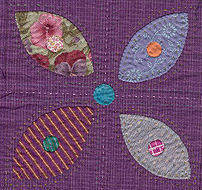
Image via Wikipedia
The traditional technique applied to put together collectively quilt blocks is sewing by hand with a needle and thread. Even if you possess a sewing machine you should practice these stitches. Remember to select the smallest size needle that you are able to comfortably work with. Make sure that you are using special quilting thread. Quilting thread is thicker, more durable and doesn't tangle. Cut a piece of quilting thread about two feet long. Thread the needle and place a single knot in the end of the thread with a short tail to prevent unraveling. Don't double the thread. Sew with one single strand.
Put the two quilt pieces that you are joining together, with right sides facing one another. Pin them using three pins. Place one pin in each of the top two corners, and the third pin in the middle of the piece. Begin at one corner and poke the needle through both layers of material then bring it up through the material about 1/8th of an inch down the seam line. Take one backstitch to keep your end secure, then keep going in and out stitching. This is a running stitch, also called a piecing stitch. It takes practice to acquire a straight line. You may draw the line in pencil on the wrong side of the material if this helps. Once you have reached the other corner take a backstitch in reverse and make a 90-degree turn into the seam allowance. Make two stitches and cut the thread. Many quilters don't knot the ends of their thread, as they feel knots fray and wear thin the fabric faster.
Another stitch that beginners should learn is the appliqué stitch. In appliqués blocks a material motif is cut out, layered and stitched onto the background of another material. This method of sewing the layers together needs to be almost invisible to the eye. The appliqué stitch should leave a small visible dot of a stitch. To begin, start with a quilting needle and knotted quilting thread in a color that blends with the appliqué motif. Organize the design by basting the raw edges under. Pressing with the tip of an iron first will help. Next baste the material motif onto the background material in the desired position.
Now it's finally time to appliqué. Start by placing the needle under the background material. Push the needle up through the background material and the edge of the appliqué motif. Pull the thread through both layers. Now position the needle right next to where the thread comes up, but only on the background material. Make an1/8th inch stitch through the background material and bring it up at the edge of the appliqué motif. Continue this stitch surrounding the material motif, ending underneath the background material on the wrong side. Knot and trim.
Hand stiched seems like a very time consuming process. Once you develop a rhythm, it proceeds much faster. Handstitched quilts are often appreciated over machine-stitched creations.
Put the two quilt pieces that you are joining together, with right sides facing one another. Pin them using three pins. Place one pin in each of the top two corners, and the third pin in the middle of the piece. Begin at one corner and poke the needle through both layers of material then bring it up through the material about 1/8th of an inch down the seam line. Take one backstitch to keep your end secure, then keep going in and out stitching. This is a running stitch, also called a piecing stitch. It takes practice to acquire a straight line. You may draw the line in pencil on the wrong side of the material if this helps. Once you have reached the other corner take a backstitch in reverse and make a 90-degree turn into the seam allowance. Make two stitches and cut the thread. Many quilters don't knot the ends of their thread, as they feel knots fray and wear thin the fabric faster.
Another stitch that beginners should learn is the appliqué stitch. In appliqués blocks a material motif is cut out, layered and stitched onto the background of another material. This method of sewing the layers together needs to be almost invisible to the eye. The appliqué stitch should leave a small visible dot of a stitch. To begin, start with a quilting needle and knotted quilting thread in a color that blends with the appliqué motif. Organize the design by basting the raw edges under. Pressing with the tip of an iron first will help. Next baste the material motif onto the background material in the desired position.
Now it's finally time to appliqué. Start by placing the needle under the background material. Push the needle up through the background material and the edge of the appliqué motif. Pull the thread through both layers. Now position the needle right next to where the thread comes up, but only on the background material. Make an1/8th inch stitch through the background material and bring it up at the edge of the appliqué motif. Continue this stitch surrounding the material motif, ending underneath the background material on the wrong side. Knot and trim.
Hand stiched seems like a very time consuming process. Once you develop a rhythm, it proceeds much faster. Handstitched quilts are often appreciated over machine-stitched creations.

![Reblog this post [with Zemanta]](http://img.zemanta.com/reblog_e.png?x-id=535fd1f8-7eec-48c2-8a19-c0215b14d228)
No comments:
Post a Comment